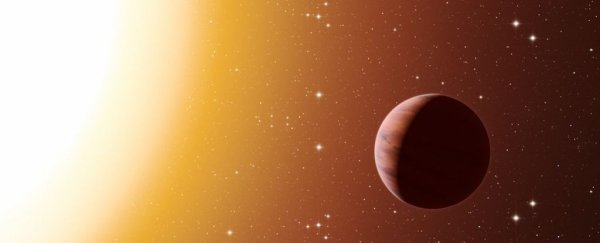An exoplanet some 1,360 light-years away is so close to its star, its clouds consist of vaporized rock.
Called WASP-178b, it orbits WASP-178, a young, white star twice the mass of the Sun, on an insanely short orbit of just 3.3 days. At that proximity, temperatures on the gaseous world are soaring – so hot that it is classified as an 'ultra-hot Jupiter', possibly the most extreme type of exoplanet we know of.
A new study of the weather on this wild world has, for the first time, identified silicon monoxide (SiO) in the atmosphere of an exoplanet, giving us new insight into these truly alien worlds.
"We still don't have a good understanding of weather in different planetary environments," said astrophysicist David Sing of Johns Hopkins University.
"When you look at Earth, all our weather predictions are still finely tuned to what we can measure. But when you go to a distant exoplanet, you have limited predictive powers because you haven't built a general theory about how everything in an atmosphere goes together and responds to extreme conditions."
Hot Jupiters in particular are absolutely fascinating and ripe for study. As the name suggests, these worlds are gas giants, like Jupiter, but they're also very hot, because they're on extremely close orbits with their stars – some whipping around in less than a day.
They pose something of an interesting conundrum: they can't have formed at their current orbit, because gravity, radiation, and intense stellar winds ought to have kept the gas from clumping together. However, over 300 hot Jupiters have been detected to date; astronomers believe that they form farther from their stars, and migrate inwards.
WASP-178b is around 1.4 times the mass of Jupiter, and around 1.9 times its size. Puffed up by the heat of its star, the exoplanet reaches temperatures of 2,450 Kelvin (2,177 degrees Celsius, or 3,950 degrees Fahrenheit). That temperature is the sweet spot for detecting vaporized silicate: theoretical studies have shown that, above 2,000 Kelvin, silicon monoxide is expected to be detectable.
Here's how. The exoplanet passes between us and its host star. With each transit, some of the light from the star is absorbed by atoms in the exoplanet's atmosphere; each element absorbs or emits on a different wavelength, meaning it can be identified as a signal in the spectrum of light received from the star.
The signal is absolutely minute, as you can imagine, but by stacking transits, astronomers can amplify the spectrum to get a readable signal. Using this method, vaporized metals such as titanium, iron, and magnesium have been detected in the atmospheres of hot Jupiters.
A team of researchers led by Sing and his colleague Josh Lothringer of Utah Valley University used the Hubble Space Telescope to obtain the spectrum of WASP-178b, and found a signal unlike anything ever seen before. According to their analysis, it turned out to be silicon and magnesium.
"SiO, in particular, has not previously, to our knowledge, been detected in exoplanets," they wrote in their paper, "but the presence of SiO in WASP-178b is consistent with theoretical expectations as the dominant Si-bearing species at high temperatures."
WASP-178b is, as all known hot Jupiters, tidally locked to its star. That means one side is permanently facing the star, in permanent day, and the other is facing away in permanent night. This produces a significant difference in temperature between the two hemispheres of the exoplanet, with a rotating atmosphere that whirls around between the two.
On the exoplanet's night side it may be cool enough for the vapors to condense into clouds that rain down deeper into the atmosphere, before being blown back to the dayside where the minerals are once again vaporized.
The researchers could see no sign of this condensation on WASP-178b's terminator, the line that separates day from night. But the results suggest silicon monoxide may be present on other exoplanets for which detailed terminator observations are more visible, namely WASP-76b. If rain of rocks is present on an exoplanet, this might be the place to find it.
The team's results also show that we're getting better at peering into the mysterious atmospheres of distant worlds. This bodes well for looking at exoplanets that are smaller, and more distant from their stars.
"If we can't figure out what's happening on super-hot Jupiters where we have reliable solid observational data, we're not going to have a chance to figure out what's happening in weaker spectra from observing terrestrial exoplanets," Lothringer said.
"This is a test of our techniques that allows us to build a general understanding of physical properties such as cloud formation and atmospheric structure."
The research has been published in Nature.
